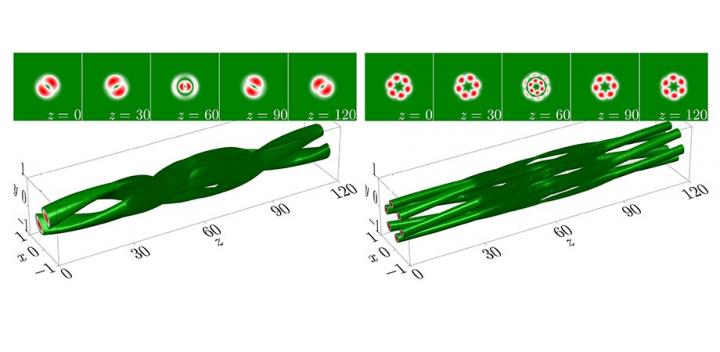Nonlinear optics research demonstrates weakly nonlinear waveguides that guarantee the stable propagation of azimuthons

Credit: Zhang et al.
The optical vortex plays an increasingly important role in optical information processing. As an information carrier, it improves the capacity of channels and offers an independent aspect for analysis–different from polarization, intensity, phase, and path. A new degree of freedom for encoding and encrypting optical information may be provided via nonlinear optics, using vortex beams known as azimuthons, which carry an orbital angular momentum and can now be made to exhibit a mutual conversion pattern known as Rabi oscillation.
A quantum effect named after 1944 Nobel Prize in Physics recipient Isidor Rabi, Rabi oscillation denotes a periodic motion–a kind of flopping–between two different energy levels in the presence of an oscillatory driving field. The effect is also investigated in photonics, where the oscillatory driving field can be mimicked by a slight periodic longitudinal modulation of the refractive index change of the medium. Until now, Rabi oscillations have mostly been studied in linear systems, but the most interesting phenomena tend to pop up in the nonlinear realm.
Azimuthons exhibit steady rotation upon propagation, but they are generally unstable, so they typically disintegrate during the process of propagation. A solution to that instability problem is found in nonlinearity, as proposed by a research team led by Yiqi Zhang from Xi’an Jiaotong University, who recently demonstrated weakly nonlinear waveguides that guarantee the stable propagation of azimuthons. Their report is published in Advanced Photonics.
Nonlinear, multimodal waveguide: from rotation to oscillation
The team determined specific requirements for a weak nonlinearity: (1) both the linear and nonlinear induced index changes are small compared to the ambient refractive index, and (2) the induced nonlinear index change is much smaller than the linear one. Their theoretical investigations demonstrated that the depth of the induced potential is tightly related to the transverse size of the waveguide. This indicated that multimode optical fibers could be used to obtain a deep potential energy well that would also allow for shallow modulation.
With these elements in mind, Zhang and colleagues developed a weakly nonlinear waveguide that is explicitly multimode. They paired various modes with different modal distributions. By introducing a π-phase shift and an amplitude modulation to one mode, and then superposing the other, they obtained an azimuthally modulated vortex. Thanks to the presence of nonlinearity and a weak longitudinally periodic modulation to the potential, the azimuthally modulated vortex rotates with a fixed angular velocity during propagation and exhibits Rabi oscillation (flopping) between the two modes.
The authors noted that the spatial symmetry of the propagating beam will change periodically in the process. According to coupled-mode theory, Rabi oscillations are mainly affected by the longitudinal modulation strength and the spatial symmetry of the superposed azimuthons. Without longitudinal modulation, the azimuthon rotates with a constant velocity and its profile is preserved. But, with slight longitudinal modulation, mutual conversion of different azimuthons can be observed during propagation: the Rabi oscillations.
Senior author Yiqi Zhang, associate professor at the School of Electronic Science and Engineering of Xi’an Jiaotong University, remarks, “Since our model supports higher order azimuthons with higher topological charges, there are many choices to select the orbital angular momentum carried by the light beams. However, the Rabi oscillation can only happen between azimuthons with certain profiles. We now have some ideas for how to overcome that limitation, so we’ll continue our investigations.”
Varieties of vortices
Beyond its promise for enhancing optical information processing, the demonstration of Rabi oscillations of azimuthons contributes to a better understanding of the rotational dynamics of vortices and the inherent role of nonlinearity in regulating those dynamics. Intrigued by spatial field manipulation in nonlinear optical systems, the authors note that their findings are important for potential advances in photonics, for example in helical waveguides or topological insulators. More broadly, their insights may contribute to improved understanding of such everyday phenomena as cyclones or tornados, or vortices forming in the wake of an airplane.
###
Read the original peer-reviewed, open access article, “Rabi oscillations of azimuthons in weakly nonlinear waveguides,” Advanced Photonics, 2(4), 046002 (2020), doi: 10.1117/1.AP.2.4.046002.
Media Contact
Daneet Steffens
[email protected]
Original Source
https:/
Related Journal Article
http://dx.




